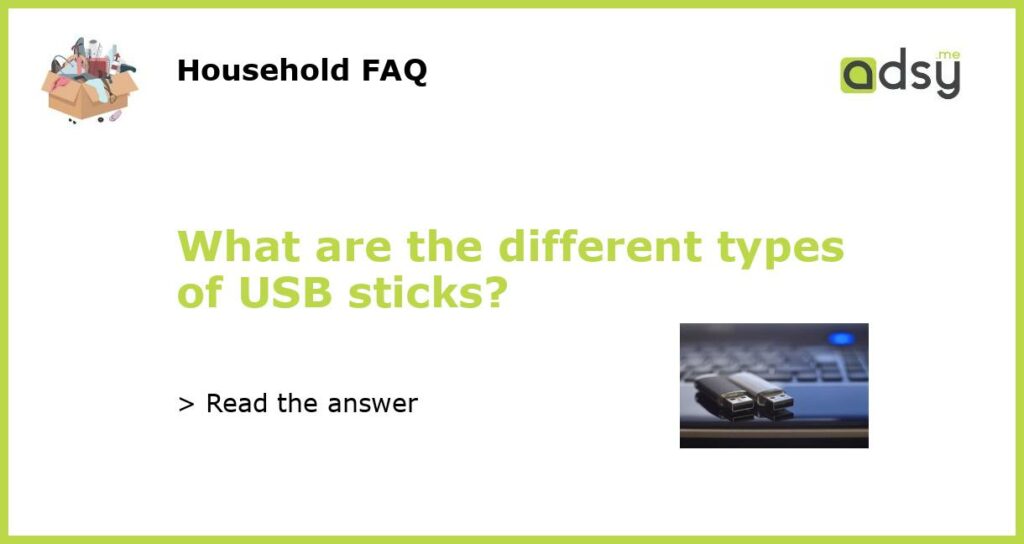Types of USB Sticks: Explained
USB sticks, also known as flash drives or thumb drives, have become an essential tool in today’s digital world. They are portable, versatile, and offer convenient storage options. However, with the advancement of technology, there is a wide range of USB sticks available, each with its own unique features and functions. In this article, we will explore the different types of USB sticks and their uses.
USB 1.0/1.1
USB 1.0 (later updated to 1.1) was the first widely adopted standard for USB sticks. These early USB sticks came with a small storage capacity, typically ranging from 64MB to 512MB. Although their storage capacity was limited, they played a vital role in data transfer and file sharing during the early 2000s. USB 1.0/1.1 sticks are now considered outdated, as they offer slow data transfer speeds and limited storage capacity.
While USB 1.0/1.1 sticks may no longer be the preferred choice for most users, they can still be useful for transferring small files or as backup storage for older devices. However, their limited compatibility with modern devices makes them less practical for everyday use.
USB 2.0
USB 2.0 brought significant improvements over its predecessors. This version of USB sticks offered faster data transfer speeds, enhanced compatibility, and increased storage capacity options. USB 2.0 sticks typically come in storage capacities ranging from 1GB to 128GB.
USB 2.0 sticks quickly gained popularity due to their improved performance and affordability. Most devices, including computers, laptops, and gaming consoles, are compatible with USB 2.0 sticks. They are widely used for storing and transferring various types of files, such as documents, photos, videos, and software.
USB 3.0/3.1
USB 3.0 (later updated to 3.1) revolutionized the USB technology by introducing SuperSpeed data transfer rates. USB 3.0 sticks offer significantly faster transfer speeds compared to USB 2.0, making them ideal for quickly transferring large files and high-resolution media.
USB 3.0/3.1 sticks come in various storage capacities, ranging from 16GB to 2TB. They are backward compatible with USB 2.0 ports, but to fully utilize their high-speed capabilities, it is recommended to use them with USB 3.0/3.1 ports.
These USB sticks are widely used by professionals, including photographers, videographers, and graphic designers, who often deal with large file sizes. Additionally, USB 3.0/3.1 sticks are popular among gamers for storing and playing games without experiencing lag or slow loading times.
USB-C
USB-C, also known as USB Type-C, is the latest USB standard that offers significant improvements over its predecessors. The USB-C connector is smaller in size and reversible, making it more convenient to use. It supports faster data transfer speeds and higher power delivery capabilities, allowing for faster charging and file transfers.
USB-C sticks are compatible with devices that have USB-C ports. However, they can also be used with older devices using adapters or USB-C to USB-A converters.
One of the key advantages of USB-C sticks is their versatility. They can be used to transfer files between various devices, such as smartphones, tablets, laptops, and even some gaming consoles. USB-C sticks also support features like video output and charging other devices, making them a multi-functional accessory.
Wireless USB Sticks
Wireless USB sticks, also known as Wi-Fi USB sticks or Wi-Fi dongles, eliminate the need for physical connections. These USB sticks connect to devices via Wi-Fi and allow for wireless data transfer and internet connectivity.
Wireless USB sticks are particularly useful for devices that do not have built-in Wi-Fi capabilities. They can be used with laptops, desktop computers, smart TVs, and gaming consoles to provide wireless connectivity.
These USB sticks often come with their own software and settings for seamless wireless connectivity. Some models even offer extended range and dual-band support for better performance.
In conclusion, USB sticks come in various types, each offering its own set of features and benefits. From the early USB 1.0/1.1 sticks to the latest USB-C and wireless options, there are options available for different needs and preferences. Consider your specific requirements, such as storage capacity, data transfer speed, and device compatibility, when choosing the right USB stick for your needs.






